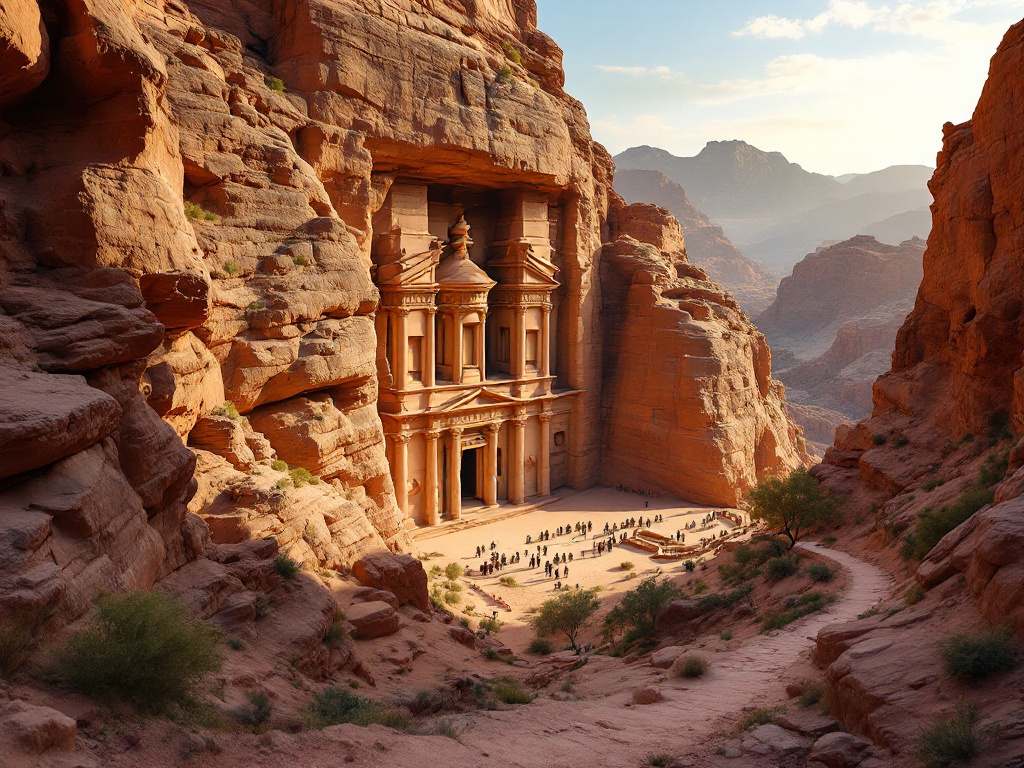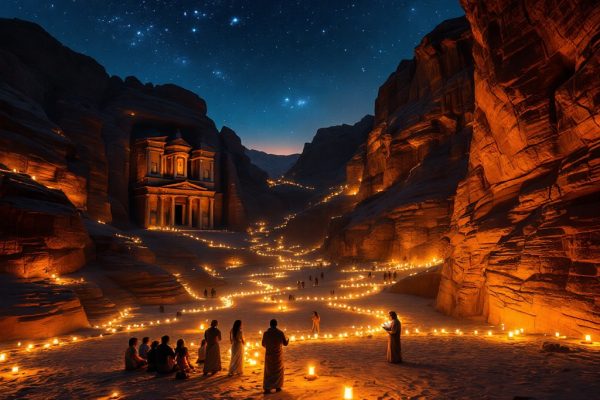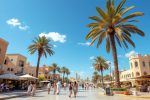Exploring the Petra Monastery: Discover the Beauty of Jordan
Journey to Jordan and uncover the ancient wonder of Petra’s Monastery, a colossal monument carved into sandstone cliffs. This breathtaking site, the largest in Petra Archaeological Park, boasts a 50-meter-wide facade towering 45 meters high. Explore its fascinating transformation from a Nabataean tomb to a place of worship, and discover intricate carvings that showcase the ingenuity of this ancient civilization. The rewarding hike to the Monastery offers stunning panoramic views, and guided tours provide rich historical insights. Plan your adventure today and experience the allure of Petra’s Monastery.
Important information

- Petra’s Monastery, a massive monument carved into sandstone cliffs, is the largest structure in Petra Archaeological Park and dates back to the 1st or 2nd century.
- Reaching the Monastery requires an hour-long hike up approximately 800 steps, but donkeys and horses are available for those who prefer not to walk.
- The Monastery’s facade is an impressive 50 meters wide and 45 meters high, showcasing intricate Nabataean carvings and a blend of Hellenistic and Roman architectural influences.
- Originally a Nabataean tomb, the Monastery later became a place of worship, reflecting the evolving cultural landscape of the region.
- Visitors are advised to wear comfortable shoes, bring water, and start their hike early to avoid crowds and the midday heat. Guided tours are available for a richer experience.
The Allure of Petra’s Monastery: Discovering an Ancient Wonder
Petra’s Monastery, an ancient marvel in the heart of Jordan, awaits exploration. Dating back to the 1st or 2nd century, this colossal monument, the largest within Petra Archeological Park, originally served as a Nabataean tomb before its transition into a place of worship. Its immense facade, spanning approximately 50 meters wide and rising 45 meters high, commands attention. Inside, a spacious hall hints at its past use as a sacred gathering space, all enhanced by the majestic backdrop of surrounding cliffs and valleys.
Visiting the Monastery
Intricate carvings adorn the Monastery, showcasing the Nabataeans’ artistic prowess. Reaching this breathtaking site requires a challenging yet rewarding hour-long hike uphill from the Siq. For a less strenuous alternative, donkey and horseback rides are available.
The 3.5-kilometer journey from Petra’s main entrance presents stunning panoramic views.
The Monastery’s Architecture
The Monastery’s architecture itself is a fascinating blend of Hellenistic and Roman influences, a testament to Nabatean ingenuity in rock-cut architecture and engineering. Guided tours further enrich the experience, providing valuable insights into the rich culture and history of this remarkable civilization.
Historical Significance of the Petra Monastery
Originally a Nabataean tomb from the 3rd century BC, the Petra Monastery, or Ad Deir, reveals the site’s evolution into a vital cultural and religious hub.
From Nabatean Tomb to Religious Site: The Monastery’s Transformation
Carved from sandstone cliffs, Petra’s Monastery originally served as a Nabataean tomb. Later, it was repurposed into a religious site, demonstrating the changing cultural landscape of the region. This shift highlights the Nabataeans’ adaptability and the enduring significance of the site.
Architectural Marvel: Sandstone Carvings and Ornate Facade
The Monastery’s sandstone facade, a testament to Nabataean architecture, is adorned with intricate carvings and ornate windows. This striking design creates a visual masterpiece, making it an iconic, postcard-perfect landmark.
Impressive Dimensions: Height and Structure of the Monastery
The Monastery’s impressive facade towers 45 meters high and spans an impressive 50 meters in width, enclosed by a massive, amphitheater-like wall reaching 48 meters high.
Journey to the Monastery: An Adventurous Exploration
The climb to Petra’s Monastery involves about 800 steps, accessible from the main entrance of Petra Archaeological Park. The hike generally takes between 30 and 60 minutes, depending on your pace. Donkeys and horses are available to assist with the ascent. Along the path, stunning views of the surrounding mountains and valleys unfold. Comfortable shoes and water are recommended. To enrich your experience, consider a guided tour for valuable historical insights.
Access the 800 steps to Petra’s Monastery from the main entrance of Petra Archaeological Park.
Anticipate a 30 to 60-minute hike, adjustable to your preferred pace.
Utilize available donkeys or horses for assistance during the ascent.
Enjoy breathtaking views of the surrounding mountains and valleys along the path.
Wear comfortable shoes and carry water for a pleasant trekking experience.
Enhance your visit with a guided tour to gain valuable historical insights.
The Climb: Conquering 1000 Steps to Reach the Monastery
Reaching Petra’s Monastery involves climbing around 800 steps, a key part of the journey. The path upwards offers stunning views of the surrounding mountains and valleys. The climb usually takes 30 to 60 minutes, but the exact time depends on your own pace.
Breathtaking Views: What to Expect Upon Arrival
Embark on a journey to Petra’s Monastery and be captivated by the breathtaking panoramic views of Wadi Araba.
Carved directly into the sandstone cliff, the Monastery’s impressive facade measures approximately 50 meters wide and 45 meters high, further enhanced by the surrounding landscape of dramatic cliffs and vast valleys.
Visitor Experience: Enhancing Your Journey in Petra
To maximize your Petra experience, arrive early to beat the crowds and the midday heat. Comfortable walking shoes are a must for exploring this expansive site. Remember to bring plenty of water, especially during summer, to stay hydrated.
- Start early to avoid crowds and heat.
- Wear comfortable shoes for extensive walking.
- Bring plenty of water, especially in summer.
- Consider a local guide for historical insights.
- Utilize donkey or camel rides if needed.
- Respect local customs.
After exploring, especially near the Monastery, indulge in the culinary delights of traditional Jordanian restaurants. Savor local specialties like mansaf (lamb and rice) or maqluba (meat, rice, and vegetables). Complete your meal with refreshing juices and aromatic Arabic coffee.
- Enjoy traditional Jordanian cuisine after your visit.
- Try local dishes like mansaf and maqluba.
- Refresh with fresh juices and Arabic coffee.
Tips for Exploring Petra: Best Practices for an Unforgettable Visit
Plan your trip to Petra and maximize your experience. Remember to stay hydrated, especially before climbing the 800 steps to the Monastery. Take your time to admire the stunning architecture and rich history once you arrive. Due to the climb’s difficulty, it’s recommended to start early in the day to avoid the midday heat. Don’t forget your entry ticket and be sure to respect the local customs. Capture the unique architecture and breathtaking views. Consider a guided tour for a deeper understanding of the Monastery’s significance, which will enhance your overall visit.
Hydration is essential, especially for the challenging climb.
Start your climb early to avoid the midday sun.
Remember your entry ticket.
Be respectful of local customs.
Maximize your Petra experience: plan your trip and stay hydrated.
Climbing the Monastery: It’s a challenging 800-step climb, so start early to beat the heat.
Exploring the Monastery: Take your time to appreciate the stunning architecture and rich history.
Essential items: Remember your entry ticket.
Respect local customs: Show consideration for local traditions.
Enhance your visit: Consider a guided tour for a deeper understanding.
Traditional Jordanian Restaurants: Culinary Delights Near the Monastery
After exploring Petra’s Monastery, treat yourself to the flavors of Jordan at a nearby traditional restaurant. These local eateries offer a welcome break after the strenuous climb, enhancing your cultural immersion. Savor authentic dishes like mansaf, a classic lamb meal, or maqluba, a flavorful upside-down rice dish. And don’t forget to finish with a refreshing glass of mint tea – the perfect complement to your Jordanian dining experience.












